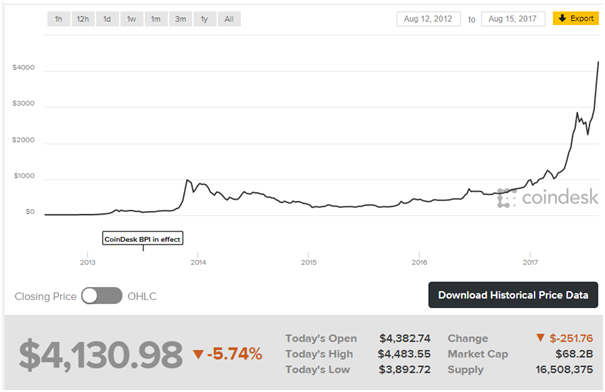Making a mint with Initial Coin Offerings

A few weeks ago on the Master Investor blog Nick Sudbury argued that investors, given the current environment of rising inflation, should be looking at ways to protect their wealth from currency debasement.
One way of doing that is to invest in cryptocurrencies such as bitcoin, the increasingly popular Ethereum, or perhaps one of 900+ other digital currencies which are now estimated to have been created. The theory is that, by having a fixed supply (or known rate of new coin creation), cryptocurrencies are able to hold their value better than fiat currencies (such as the pound, dollar, euro etc.) which can have their supply increased in an instant by the actions of central banks and governments.
However, over the past few years cryptocurrencies have become much more than an inflation hedge. Take bitcoin for example, the world’s most established and well known cryptocurrency. Seven years ago today one bitcoin (XBT) was being valued at just 7 US cents. As I write that value has gone up to just short of $4,131 – a gain of 5,901,328%. In other words, someone buying just $16.95 of bitcoin back in August 2010 would now be worth a million dollars!

But that’s not the only area of cryptocurrencies capturing investors’ attention.
Since early 2013 a concept known as an Initial Coin Offering (or ICO) has become increasingly popular as a way of raising funds for companies operating in the blockchain industry – for those not familiar with blockchain (it is a complex subject) it is the technology behind what makes bitcoin and other cryptocurrencies work.
Put simply, an ICO sees funds raised for a new blockchain/cryptocurrency venture, with a percentage of the new cryptocurrency (or tokens) sold to investors in exchange for either cash or other cryptocurrencies. The tokens sold will usually be a key component of the new venture. Because this form of fundraising is (arguably) unregulated it has a number of advantages, especially in terms of time and costs for the issuing company. One of the most successful ICOs to date was undertaken by blockchain platform Ethereum in summer 2014. Its ICO raised $18 million in bitcoin, or $0.40 per “Ether” at the time, with the tokens now valued at just over $290 each.
ICOs are growing so quickly that the cumulative total raised is shortly set to overtake the $1.8 billion raised by blockchain start-ups through traditional venture capital firms.
Research from digital currency website Coindesk shows that a combined $1.73 billion has been raised via ICOs since the start of 2014. This has accelerated significantly in the past few months, with c.$1.27 billion being raised in the three months to July 2017 alone. According to data from Coindesk, ICOs are growing so quickly that the cumulative total raised is shortly set to overtake the $1.8 billion raised by blockchain start-ups through traditional venture capital firms.
Records continue to be broken on almost a weekly basis.
Just last week an initial coin offering for the blockchain data storage network Filecoin raised an estimated $200 million in just one hour, despite the issue being hampererd by technical problems. With an additional $52 million banked in a pre-sale this made the ICO the largest to date, overtaking the $232 million raised by blockchain business Tezos in mid-July and the $150 million raised by Bancor, a platform for launching new blockchain tokens, in mid-June.
Why are investors so excited?
There is clearly a lot of hype round the ICO market at present, with investors attracted to the potential of blockchain technology, the phenomenal rise in value of Bitcoin and Ether and the relative ease by which normal punters can get involved in ICOs – most are available on digital asset exchanges. The underlying investment case of ICOs is that investors are hoping the business plan of the issuing company will be successful and in reaction the value of the associated cryptocurrency will rise in value on secondary markets.
However, there are clearly huge risks involved in cryptocurrency investing.
For starters, many industry commentators are suggesting that we are in the middle of a huge bubble akin to that seen in internet stocks at the start of the century. This is especially so given that many ICO issuers are raising huge amounts of money but as yet have unproven concepts. With a new digital currency now seemingly being created every day or so, not all are going to be successful.
And investing in an ICO is not like buying shares in a company. Unlike shares, investors are not entitled to dividends, nor do they receive any voting rights in a company with their issued tokens. Just like gold, they are only worth what other investors are willing to pay for them. What’s more, cryptocurrencies can be subject to wide swings in valuation, even on an hourly basis, with several large falls being seen in the value of Bitcoin and Ether following successful hacking attempts.
Regulatory pressures are also starting to increase, with US watchdog the Securities and Exchange Commission (SEC) issuing an investigative report at the end of July which cautioned market participants that offers and sales of virtual coins or tokens may be considered as “securities” and as such subject to the federal securities laws.
Fortunately, there are ways of getting involved in cryptocurrencies, blockchain and ICOs while reducing risk.
For investors wanting to spread risk between a number of early stage companies in the industry, two London listed companies stand out.
NEX Exchange listed Coinsilium (COIN) is an accelerator that finances and manages the development of early-stage blockchain technology companies. It recently exited from an investment in nanopayment platform SatoshiPay for a gain of 363% in under two years and saw investee company Indorse close its blockchain token pre-sale, with proceeds reaching 18,396.21 Ether (equivalent to c.$5.37 million) in three days.
Also on NEX Exchange is Kryptonite 1 (KR1) which has the twin strategy of purchasing private equity in blockchain companies and investing in the blockchain based token economy. Demonstrating the opportunities on offer the company recently disposed of tokens in two investee companies, one at twenty-seven times the price of the original investment and another at a multiple of 8.6 times the initial investment made only four months earlier.
For those investors who actually want to spend the cryptocurrencies they hold, LOTcard, a company which is set to launch its own ICO, is looking to launch a bank card that allows a user to hold their cryptocurrencies safely while being able to spend them in the form of multiple fiat currencies. An accompanying app will combine FX with crypto currencies, allowing the user complete control over their cash for the first time. Its product is expected to be on the market by the end of 2017.
Comments (0)